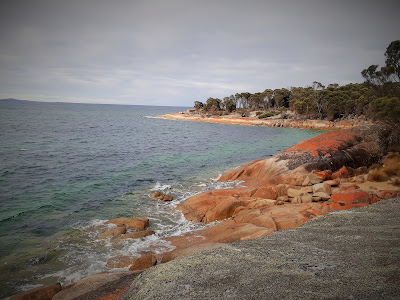Gidday all,
East coast Flinders Island.
After a few days relaxing at
the northeast tip of the Island we started the journey down the east coast.
Firstly though we called into Palana, on the western tip, as we bypassed it on
the way to Northeast River. Also Killiecrankie, a small bay famous for the
Killiecrankie diamonds found along the shoreline. These are Topaz stones and
are getting harder to come across now days. We didn’t find any but had a nice
afternoon strolling the beach.
Having ticked off all
destinations on the western side we crossed over to the east. Patriarch Inlet, half
way down the east coast, the first place accessible by road, is at the end of a
well formed gravel track where you come out onto a large tidal flat that
stretches out to the turquoise waves of the Tasman sea. There’s a small car park and nothing else. So,
as we do, we camped up for the night and explored the inlet and beach at low
tide the next morning. Once out on the beach, it stretches on for ever. No
other soul in sight but thousands of soldier crabs marching over the tidal
flats. The red hues of their bodies changing the colour of the sands for as far
as you can see. A magical sight.
Off down the road to
Patriarch wildlife sanctuary, a privately maintained area, the dream of founder
Denis Smith, now passed on, but keeping the dream alive are a small bunch of
volunteers who caretake the area. There’s an A-frame building with wood heater
and all the conveniences and HOT SHOWERS. You can camp and enjoy. Only a
donation is asked for in the box provided, for help with upkeep. A real gem to
come across.
The Patriarchs are three
granite mountains overlooking the sanctuary they
were named by Matthew Flinders when he first saw them. The sanctuary is a
habitat for wombats, wallabies, Cape Barren Geese and many other birds. We were
lucky enough to interact with some wallabies, who came out to get some food
which is supplied for them in the hut. Also saw an echidna but no wambats,
though you could see where they had been. We fell in love with the place and
spent three days there, no one else to be seen.
Getting short on fresh veg
and bread, a trip back to Whitemark was in order. Only a short drive really,
but you feel you are alone, miles away from anyone. While in town, we were
looking forward to a treat of a local produce meal at the restaurant on the
wharf there, but it had closed due to Tassie closing its boarders to people to
control the Coronavirus spread, and so the customer base had dried up. A
lobster meal had to wait, so we found a local shop and got some home-made
sauces, olive oil, lavender vinegar and other Island delicacies.
Back to the east coast and
out to Cameron Inlet. The day was getting late and we came across an old,
abandoned farm shed, on its own in a paddock near the road on our way to the
Inlet, looking like rain, I drove round the back and in through the large back
door for a nice sheltered night camp.
Out to the Inlet the next day and another
pristine beach walk, an amazing array of brightly coloured shells littered the
beach, having us stop every few meters admiring them.
One thing you can say for
Flinders Island is, as yet, it hasn’t been invaded with hoards of tourists and,
due to that and I’m sure, the respect the locals have of their home, we have
not come across any rubbish or disrespect of the natural environment that we
find in so many other places we visit. A true testament to the people who live
on and care for this beautiful little Island, I hope it stays that way.
The clock is ticking, and
with only a few days left till we make the dreaded, heaving voyage back to
Tassie, we have come full circle to a campsite we first camped at on our
arrival. We have driven every road on the maps and some that aren’t. We will
pull up here and tidy up as well as secure everything in preparation for the
hopefully calm trip back. It has been a thoroughly enjoyable and unforgettable
experience.



























